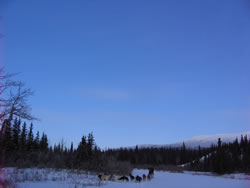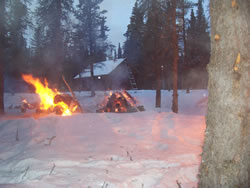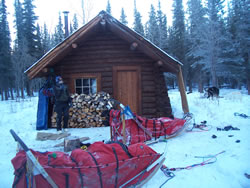
National Fire Plan Success Story
Working with Winter Elements, Fire Management, Denali Kennels Staff and Sled Dogs Get the Job Done!
Denali National Park and Preserve, Alaska
National Fire Plan - Fuels Reduction
2011

Surrounded by winter light, sled dogs head to cabin. NPS photo.

Burning piles near cabin. NPS photo.

Sleds are packed and ready for transport back to headquarters. NPS photo.
Making remote structures in Alaska national parks Firewise can be challenging. Projects present logistical challenges, consume time, and are expensive. Also, burning piles in the summer can be risky. Fortunately, where there is a will, there is a way! In an effort to reduce costs and get the job done safely, Western Area Fire Management staff at Denali National Park and Preserve recently took advantage of winter conditions and a traditional and cheaper means of transportation to burn piles around the Lower Savage patrol cabin.
On February 11, 2011, park mushers and two dog sled teams transported staff to the backcountry cabin. For two days, fire employees ignited and monitored piles of woody debris. During the summer of 2008 fire personnel thinned vegetation around the cabin in order to create defensible space, reduce the wildfire risk and decrease the time necessary to install structure protection equipment when a fire is near. Staff placed cut black spruce and other flammable vegetation into piles that surrounded the cabin. Burning the debris marked the final step in creating a Firewise cabin.
As day three dawned, temperatures ranged around -40F. Kennels staff were scheduled to mush to the cabin that morning to pick up the fire specialists but opted to travel in the afternoon when the temperature lingered near -10F. Temperatures again plummeted and everyone hunkered down in the cabin that night. On the afternoon of the fourth day, dogs and staff traveled safely to Denali headquarters, having accomplished what they set out to do. Come summer, if threatened by wildfire, the survivability of the Lower Savage patrol cabin will be higher. Most importantly, firefighters, protecting the cabin, will have a safer area in which to work.
Contact: Gilbert Garcia, Helicopter Manager, (907) 683-6220